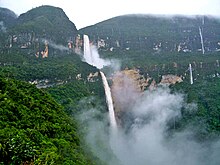User:Jfelmgart/Tourism in Peru
Legend:
Main text: Plain text
My prose: Bold
My copyedits: Underlined
| This is the sandbox page where you will draft your initial Wikipedia contribution.
If you're starting a new article, you can develop it here until it's ready to go live. If you're working on improvements to an existing article, copy only one section at a time of the article to this sandbox to work on, and be sure to use an edit summary linking to the article you copied from. Do not copy over the entire article. You can find additional instructions here. Remember to save your work regularly using the "Publish page" button. (It just means 'save'; it will still be in the sandbox.) You can add bold formatting to your additions to differentiate them from existing content. |
Article Draft[edit]
Article body[edit]
Ecotourism[edit]

The landscape of Peru is beautiful and diverse lending itself to tourism, and also ecotourism. The ecological diversity allows for ecotourism that is distinct for each region. Peru is home to mountains, rainforests, and miles of beaches that are all accessible to ecotourists looking to absorb all that Peru has to offer. 60% of the land of Peru is in the Amazon Basin, and 74% of the land is covered by the Amazon rainforest itself. Peru has a higher percentage of land area protected in national parks and reserves than any other country in South America. The Peruvian Amazon is one of the most pristine, virgin, and untouched rainforests on the earth, making it a destination for tourists interested in nature and ecology.
Increased ecotourism has prompted increased tourist infrastructure. Nearly 1 million hectares (and counting) of the rainforest has been decimated between 2001 and 2015 with the following main causes: deforestation and soil degradation, small and medium-scale agriculture, large-scale agriculture, pasture for livestock, gold mining, coca cultivation, and road construction.[1] The threat of ongoing destruction to the Amazon draws tourists to Peru through ecotourism and environmental voluntourism. Many small communities in Peru suffer from deforestation and other negative environmental impacts. Ecotourism, conservation, and reforestation are possible solutions.

The Peruvian Amazon is divided into two areas: the High Jungle and the Lower Jungle. The High Jungle is more easily accessible, while the Lower Jungle is more pristine and untouched. In recent times, however, the government has increased accessibility to the Lower Jungle. Both areas contain an unrivaled diversity of animal and plant life. Large national preserves of interest to tourists include the Manú National Park, Rio Abiseo National Park, Pacaya Samiria National Reserve, and the Tambopata-Candamo Protected Area. Tourist agencies in these areas promote eco-friendly tourism to preserve the fragile ecosystems of the rainforest.
In the Áncash region, tourists also experience the mountainous terrain of the Andes. The region has two mountain ranges of the Andes; the Cordillera Negra, a dark line of mountains without any glacial peaks and the Cordillera Blanca, a line of snowcapped mountains with glaciers. Huascarán, the tallest point in Peru and the fourth highest mountain in the Americas. The region also hosts Huascarán National Park, which holds biodiversity of various flora and fauna, being a World Heritage Site since 1985.[2]
In the Piuria region, tourists flock to the gorgeous beaches and there are lots of surfers who travel in order to catch the waves. There are lots of beaches near Talara, "tourist capital of Piuria"[3] and since it is located on the Equator, there is beautiful weather all year round. Along with beaches and surfing, Piuria boasts of forest, wildlife, and its own distinct dry forest ecosystem. The non-profit organization, Ecoswell, now offers opportunities for dry forest ecotourism in Piuria,[4] specifically in Lobitos and surrounding towns. EcoSwell employs locals who understand the land and show ecotourists the best parts.
References[edit]
- ^ Finer, Matt (2017-02-14). "MAAP SÍNTESIS #2: PATRONES Y DRIVERS DE DEFORESTACIÓN EN LA..." MAAP (in European Spanish). Retrieved 2018-02-06.
- ^ "Parque Nacional Huascarán (in Spanish)" (PDF). parkswatch.org. Parkswatch.
- ^ "Engineers Without Borders UK". Engineers Without Borders UK. Retrieved 2022-04-25.
- ^ "EcoSwell". EcoSwell. Retrieved 2022-04-25.
